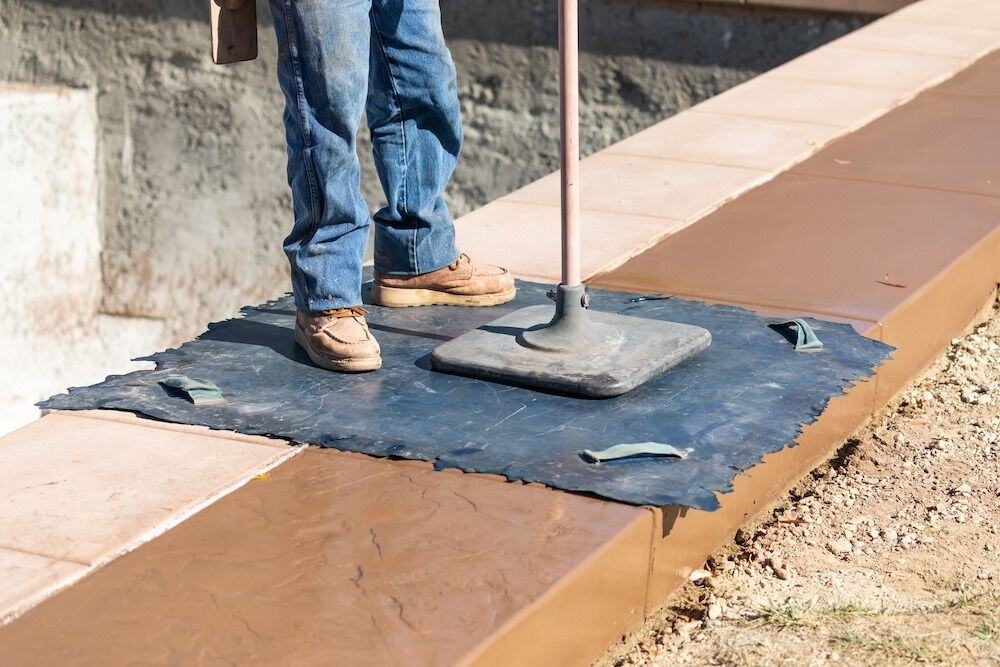6 Types of Concrete Finishes – Concrete Finishing Techniques
June 28th, 2024 | 3 min. read
By Sarah Etler

Learn all about the most common concrete finishing methods.
Concrete is an incredibly versatile material, used for everything from creating beautiful patios to constructing entire buildings.
Part of this versatility comes from the way the concrete is finished – this small detail can drastically change its appearance and functionality.
Whether you're aiming for a smooth, polished look or a textured, non-slip surface, understanding the various finishing techniques will help you achieve your desired outcome for your new concrete.
Looking to replace your existing concrete? Repair may be a better alternative. Learn more here.

1. Trowel Finish
The trowel finish is the most basic and commonly used method for finishing concrete. You'll often see this smooth finish on garage or warehouse floors. Troweling can be done manually or with mechanical tools.
Related Resource: How Is New Concrete Poured?
Manual Troweling
Manual troweling involves using a hand trowel, a flat steel or magnesium blade with an attached handle, to smooth the concrete surface. The trowel is pulled across the surface to create a sleek, even finish.
Power Troweling
For larger areas, power trowels are used. These resemble large fans with blades that sit against the concrete, smoothing it out as they move across the surface.

2. Broom Finish
A broom finish is a simple yet effective way to make concrete surfaces less slippery. After the concrete has been troweled, a broom is dragged across the surface to create small ridges.
These ridges provide traction, making the surface safer when wet. This finish is ideal for driveways, sidewalks, and patios.

3. Texturing
Texturing involves creating various patterns and designs on the concrete surface.
Exposed Aggregate
By washing away the top layer of concrete, or “cream,” you can expose the underlying aggregates such as pebbles or shells. This method not only looks beautiful but also provides excellent traction.
The aggregate used in the concrete mix is typically a river rock. On the other hand, standard troweled or broom-finished concrete usually uses less attractive coarse aggregate stones with more jagged edges.
Other Textures
You can mix various materials like rose quartz, limestone, or basalt into the concrete to create unique textures and finishes.

4. Decorative Concrete
Decorative concrete is a popular choice for homeowners who want the look of more expensive materials without the cost.
Stamped Concrete
To create stamped concrete designs, panels with inlaid designs are pressed into the concrete as it cures, mimicking the appearance of brick, stone, or wood.
Stamped concrete designs look great and retain the strength and durability of concrete without the maintenance of traditional methods.
Stenciled Concrete
For those looking for a decorative finish with a little less dimension, stenciled surfaces can create a similar appearance to that of a tile, brick, or a similar pattern.

5. Grinding and Polishing
Grinding and polishing cured concrete can create a sleek, glossy finish. Concrete finished with this method is easy to maintain and, surprisingly, more slip-resistant than non-polished concrete.
Polishing Process
To grind and polish the concrete, the surface is smoothed out using concrete floor grinders with diamond abrasives. The level of polish can be adjusted depending on the desired outcome by using finer or coarser abrasives.
These surfaces can be commonly found in some grocery stores or big-box home improvement stores.

6. Salt Finish
Salt finishing is often used for pool decks and other outdoor surfaces. By applying rock salt to the top of the wet concrete and then washing it away, small pits are left in the surface, creating a unique and textured look.
This method is cost-effective and adds an interesting visual element to plain concrete surfaces.
Choosing the Right Finish for Your Project
When deciding on a concrete finish, consider the intended use and location of the surface. For example, a broom finish or textured exposed aggregate might be best for driveways, patios, and pool decks – places where slip resistance is important.
For indoor surfaces, grinding and polishing is a great option, but it may be too slick when wet for outdoor spaces.
Stamped concrete can provide a beautiful, durable finish for decorative areas, like front walkways and porches.
Replacing Your Existing Concrete?
While new concrete comes with many different options, if your existing concrete is in okay shape, you may not need to replace it at all.
Repair options, such as lifting sinking concrete slabs, or helping to conceal cracks with caulk, can revitalize your existing concrete for a fraction of the replacement cost, without the risks.
Here at A-1 Concrete Leveling, we’ve been lifting and repairing concrete for over 30 years. Learn more about our concrete repair and maintenance services, or request a free onsite cost estimate from an A-1 franchise near you.
Sarah Etler joined A-1 Concrete Leveling after receiving her Bachelor of Arts degree in English from Northern Kentucky University. As A-1's Content Marketing Manager, she works closely with industry experts to produce content that will best answer questions related to concrete repair and maintenance practices. Sarah loves living a life full of discovery and is excited every day to see what new things she can learn and share with those around her.
Topics: